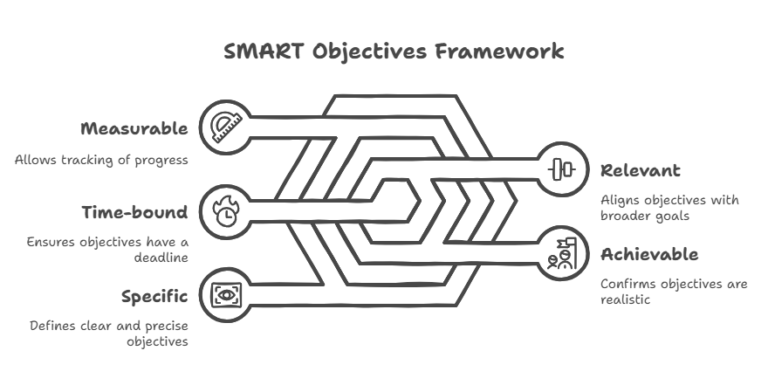Introduction
Hey there, OKR enthusiasts! Ever feel like your team is a bunch of rowing champions… but they’re all rowing in different directions? That’s where team goal alignment comes in, and let me tell you, it’s a game-changer when it comes to OKRs (Objectives and Key Results). In this article, we’re going to dive deep into the world of team goal alignment. We’ll explore why it’s crucial, how to achieve it, and how it can supercharge your OKR implementation. Whether you’re a startup founder, a team lead, or just someone trying to make sense of this whole OKR thing, buckle up – we’re about to turn your team into a well-oiled, goal-crushing machine!
Why Team Goal Alignment Matters
Before we jump into the how-to’s, let’s talk about why team goal alignment is such a big deal. Here’s the scoop:
- It boosts productivity: When everyone’s pulling in the same direction, you get more done with less effort.
- It improves morale: Nothing’s more frustrating than feeling like your work doesn’t matter. Alignment helps everyone see their impact.
- It reduces conflicts: When goals are aligned, there’s less competition and more collaboration between team members.
- It enhances focus: Aligned goals help teams prioritize what really matters, cutting out the noise.
- It drives better results: Teams with aligned goals are more likely to achieve their objectives and deliver stellar results.
The OKR-Alignment Connection
Now, you might be wondering, “What does all this have to do with OKRs?” Well, my friend, OKRs and team goal alignment go together like peanut butter and jelly. Here’s why:
1. Cascading Objectives
OKRs work on a cascading principle. Company-level OKRs inform team OKRs, which in turn inform individual OKRs. This natural hierarchy helps ensure alignment from top to bottom.
2. Transparency
One of the core principles of OKRs is transparency. When everyone can see each other’s objectives and key results, it’s easier to spot misalignments and course-correct.
3. Regular Check-ins
The OKR cycle typically involves regular check-ins. These provide opportunities to reassess alignment and make adjustments as needed.
4. Measurable Outcomes
OKRs are all about measurable results. This makes it easier to see whether different teams’ efforts are truly aligned or pulling in different directions.
How to Achieve Team Goal Alignment with OKRs
Alright, let’s get to the good stuff. How do you actually make this alignment happen? Here are some tried-and-true strategies:
1. Start at the Top
Alignment begins with clear, well-communicated company-level OKRs. These set the direction for everything else. Make sure these top-level OKRs are:
- Clearly articulated
- Widely communicated
- Understood by everyone in the organization
2. Collaborate on Team OKRs
Don’t just hand down OKRs from on high. Involve your team in the OKR-setting process. This might look like:
- Brainstorming sessions to generate ideas for objectives
- Discussions about what key results would best measure success
- Debates about what’s achievable vs. what’s too ambitious
3. Connect the Dots
Explicitly link team OKRs to company OKRs. You might even consider using a visual “OKR tree” to show how everything connects. This helps team members see how their work contributes to the bigger picture.
4. Encourage Cross-Team Collaboration
Sometimes, achieving an objective requires input from multiple teams. Encourage teams to share their OKRs and look for opportunities to support each other.
5. Regular Alignment Check-ins
Schedule regular sessions (maybe monthly) to review OKRs across teams and ensure everyone’s still pulling in the same direction. Use these sessions to:
- Celebrate aligned efforts
- Identify and resolve conflicts
- Adjust OKRs if necessary to maintain alignment
6. Use a Common Language
Ensure everyone’s on the same page by using consistent terminology. This might mean creating an “OKR dictionary” for your organization.
7. Leverage Technology
Consider using OKR software that allows for easy sharing and tracking of objectives across the organization. This can greatly enhance visibility and alignment.
Common Pitfalls in Team Goal Alignment
Watch out for these traps:
- Forced Alignment: Don’t try to make every single task align perfectly. Some wiggle room is healthy.
- Ignoring Individual Strengths: Alignment doesn’t mean everyone does the same thing. Play to individual and team strengths within the aligned goals.
- Set-and-Forget Syndrome: Alignment isn’t a one-time thing. It requires ongoing attention and adjustment.
- Overlooking Conflicts: Sometimes, misalignments aren’t obvious. Regularly look for subtle conflicts between team goals.
- Alignment at the Expense of Ambition: Don’t water down your OKRs just to make them align perfectly. It’s okay to have some tension.
Case Study: Spotify’s Aligned Squads
Let’s look at a real-world example. Spotify uses a model of aligned autonomy for its teams (which they call “squads”). Here’s how it might work with OKRs:
Company OKR:
- Objective: Become the #1 platform for podcast creators and listeners
- Key Result: Increase podcast listening hours by 50%
Team (Squad) OKR:
- Objective: Create the most user-friendly podcast creation tools in the industry
- Key Result 1: Launch in-app podcast recording feature
- Key Result 2: Achieve 90% satisfaction rate among podcast creators
Individual OKR (UX Designer):
- Objective: Design an intuitive interface for the in-app podcast recording feature
- Key Result: Achieve a task success rate of 95% in user testing
See how each level supports the one above it, while still allowing for autonomy in how the goals are achieved? That’s aligned autonomy in action!
Conclusion
Whew! We’ve covered a lot of ground, haven’t we? Team goal alignment isn’t just a nice-to-have in the world of OKRs – it’s an absolute must-have for organizations that want to make the most of this powerful framework. By ensuring that every team’s objectives and key results ladder up to the overall company goals, you create a sense of purpose and direction that can energize your entire organization.
Remember, alignment doesn’t happen by accident. It requires intentional effort, clear communication, and regular check-ins. But when you get it right, the results can be truly transformative.
Key Takeaways:
- Team goal alignment boosts productivity, improves morale, and drives better results.
- OKRs provide a natural framework for alignment through their cascading structure and emphasis on transparency.
- Achieving alignment involves collaboration, clear communication, and regular check-ins.
- Watch out for common pitfalls like forced alignment or ignoring individual strengths.
- Tools and technology can help, but alignment ultimately comes down to people and communication.
Frequently Asked Questions
- How often should we review our alignment?
While you should be mindful of alignment constantly, it’s good to have formal alignment check-ins at least monthly. This allows you to course-correct if teams start to drift apart in their focus. - What if a team’s goals don’t seem to align with company OKRs?
This is a red flag that warrants immediate attention. Have a conversation with the team to understand their reasoning. There might be a misunderstanding of the company OKRs, or the team might have insights that could inform a shift in company strategy. - Can individual OKRs align directly with company OKRs, or should they always go through team OKRs?
While it’s more common (and often more effective) for individual OKRs to align with team OKRs, which then align with company OKRs, it’s not a hard and fast rule. In some cases, especially in smaller organizations, individual OKRs might align directly with company OKRs. - How do we maintain alignment while still encouraging innovation and “thinking outside the box”?
Great question! Alignment doesn’t mean rigid conformity. Encourage teams to think creatively about how to achieve aligned goals. The “what” (the objective) should align, but the “how” (the key results and tactics) can be where innovation shines. - What’s the best way to visualize goal alignment across an organization?
Many organizations find success with an “OKR tree” or similar visual representation that shows how objectives cascade and connect. OKR software often includes features for visualizing these connections. Even a simple spreadsheet can work for smaller organizations.
Further Reading
- “Measure What Matters” by John Doerr
- “Aligned: Connecting Your True North to the Work You Do Every Day” by Hortense le Gentil
- “Team of Teams: New Rules of Engagement for a Complex World” by General Stanley McChrystal
- “Objectives and Key Results: Driving Focus, Alignment, and Engagement with OKRs” by Paul R. Niven and Ben Lamorte
- “The Advantage: Why Organizational Health Trumps Everything Else In Business” by Patrick Lencioni



